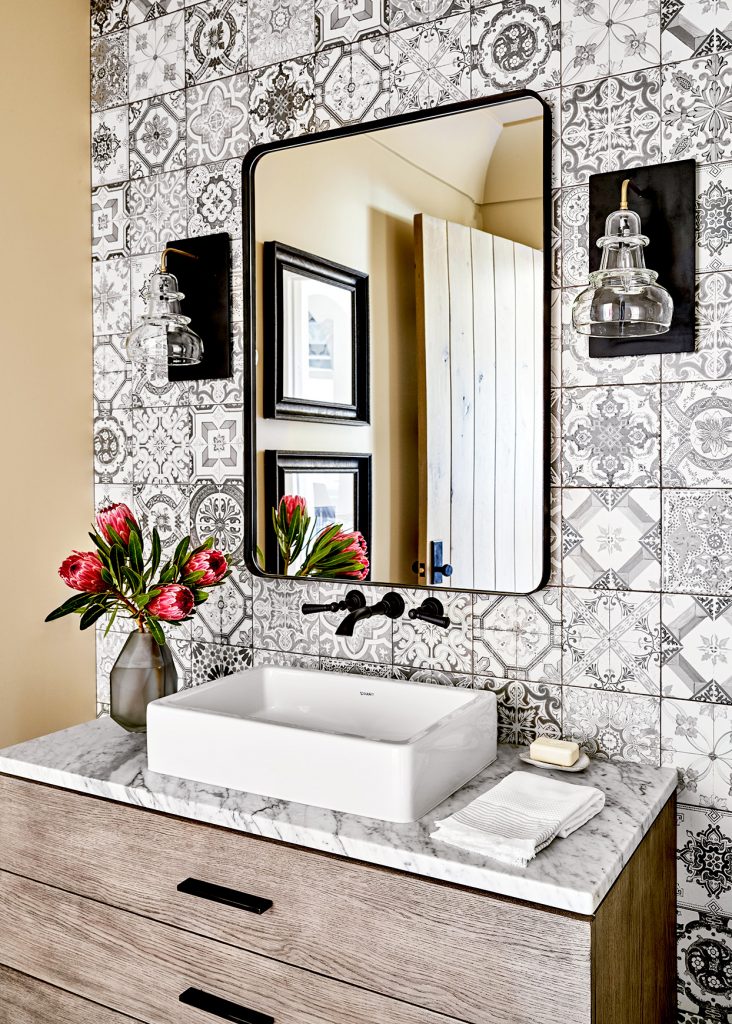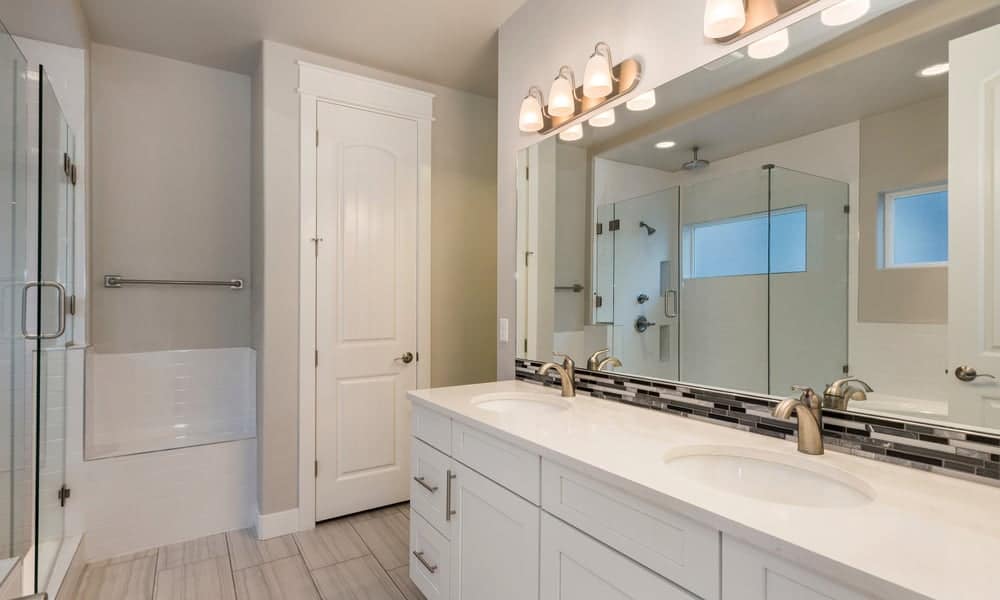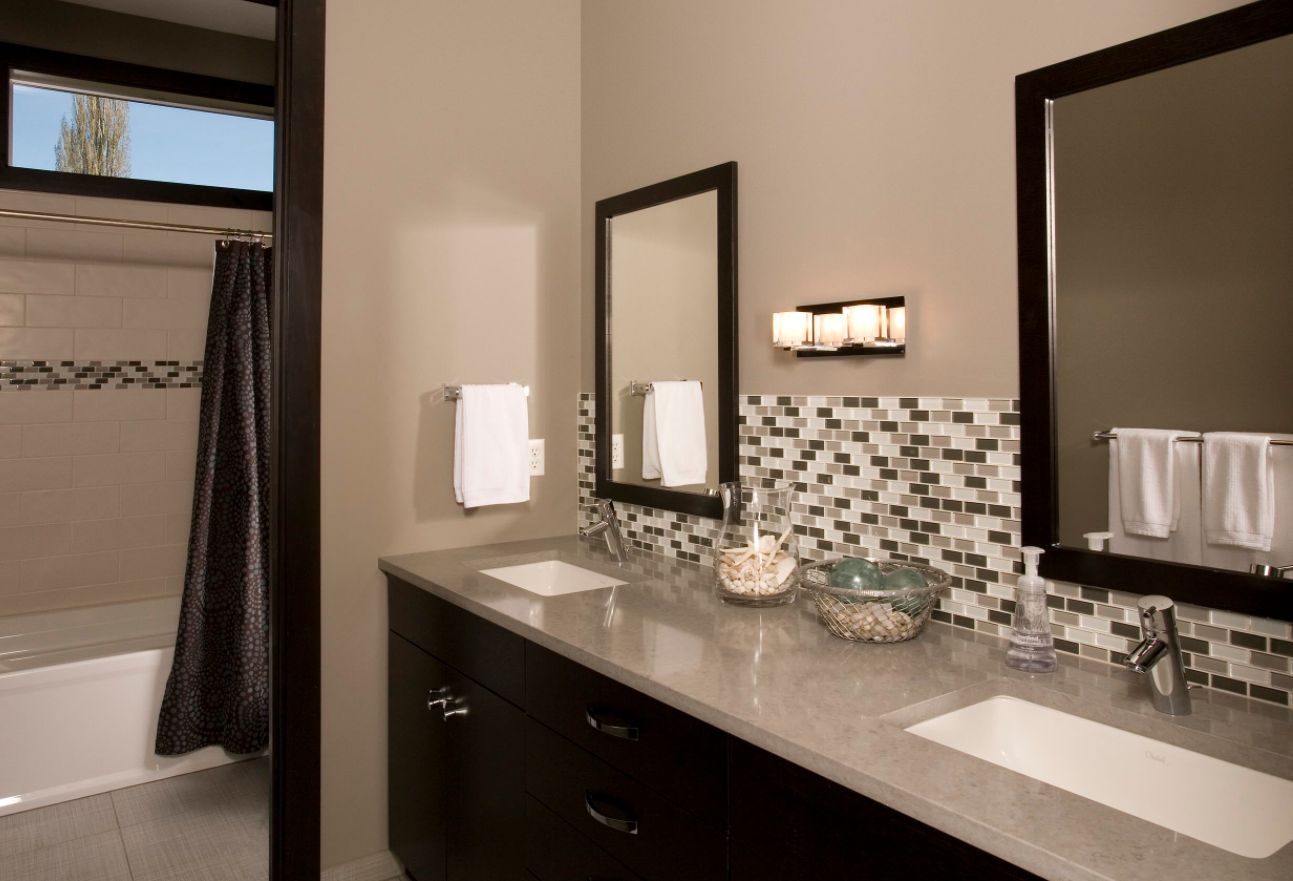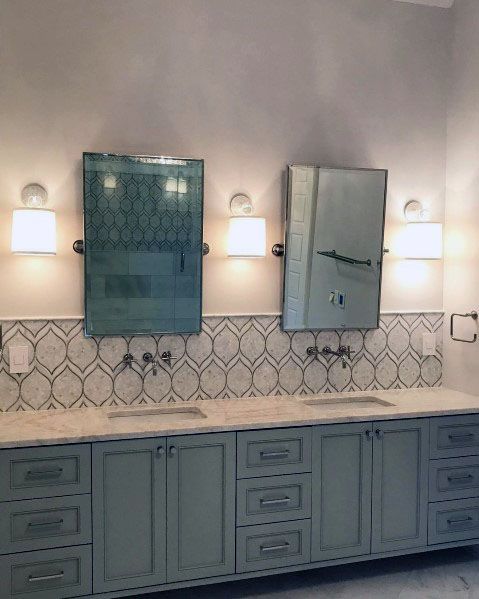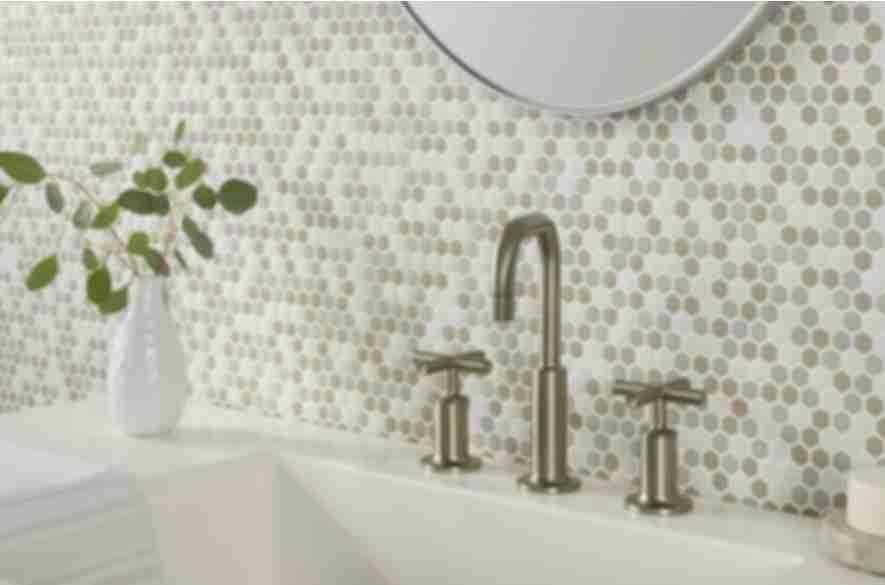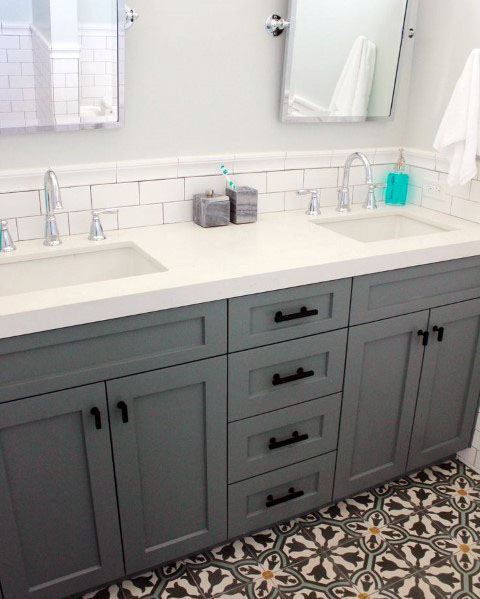Popular Materials for Bathroom Tile Backsplashes
Choosing the right material for your bathroom tile backsplash is crucial for creating a stylish and functional space. Each material has its own unique properties, advantages, and aesthetic appeal. Here’s a look at some popular options to consider.
- Ceramic Tiles: Ceramic tiles are a classic choice for bathroom backsplashes due to their versatility, durability, and affordability. They come in a wide range of colors, sizes, and finishes, making it easy to match any decor style. Ceramic tiles are also resistant to moisture and stains, making them ideal for high-humidity environments like bathrooms. Their ease of maintenance adds to their appeal, as they can be cleaned with standard household cleaners.
- Porcelain Tiles: Porcelain tiles are similar to ceramic but are denser and more durable, making them suitable for both wall and floor applications. They are less porous than ceramic, providing better resistance to moisture and staining. Porcelain tiles can mimic the appearance of natural stone or wood, offering a high-end look without the maintenance requirements of these materials. They are a great choice for creating a sleek, modern bathroom aesthetic.
- Glass Tiles: Glass tiles add a touch of elegance and sophistication to any bathroom backsplash. Their reflective surface enhances light, making small bathrooms feel larger and brighter. Glass tiles come in various shapes, sizes, and colors, allowing for creative designs and mosaic patterns. They are non-porous, resistant to stains, and easy to clean, making them both a stylish and practical choice for bathroom backsplashes.
- Natural Stone Tiles: Natural stone tiles, such as marble, granite, slate, and travertine, offer a luxurious and timeless look. Each stone has unique patterns and textures that add character and depth to the backsplash. While natural stone requires more maintenance to prevent staining and etching, its natural beauty and durability make it a worthwhile investment for many homeowners. Sealing the stone regularly helps protect it from moisture and staining.
- Metal Tiles: Metal tiles, including stainless steel, copper, and aluminum, bring a modern and industrial feel to bathroom designs. These tiles are highly durable and resistant to moisture, making them suitable for bathroom environments. Metal tiles can be used as accents or for an entire backsplash, adding a sleek, contemporary look. They are easy to clean but can show fingerprints and water spots, so regular maintenance is recommended.
- Peel-and-Stick Tiles: For a quick and budget-friendly update, peel-and-stick tiles are an excellent option. Made from various materials, including vinyl and composite, these tiles come with an adhesive backing that allows for easy installation. They are available in a range of designs, from faux stone to metallic finishes, and can be cut to fit any space. While they may not offer the longevity of traditional tiles, peel-and-stick options are perfect for renters or those seeking a temporary solution.
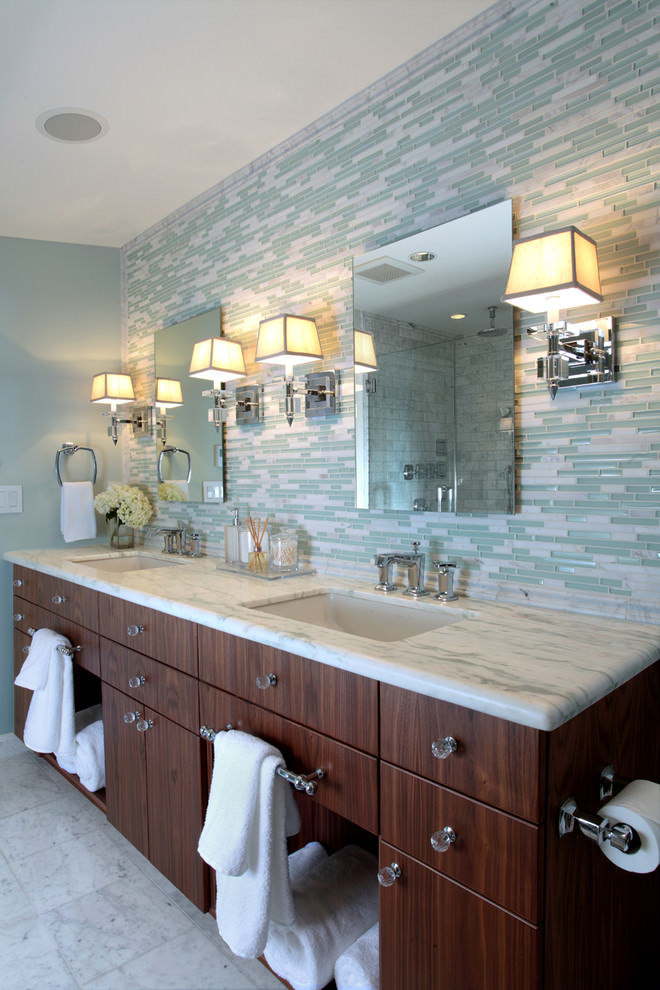
Creative Patterns and Layouts for a Unique Backsplash
Creating a unique bathroom backsplash involves more than just choosing the right tiles. The pattern and layout of the tiles play a significant role in defining the overall look and feel of the space. Here are some creative ideas to inspire your design.
Classic Subway Tile Pattern
The subway tile pattern is a timeless choice that works well in both modern and traditional bathrooms. This pattern typically involves rectangular tiles laid in a horizontal brick-like formation. To add a twist, consider using colored grout for contrast or arranging the tiles vertically for a fresh take on this classic look. Subway tiles can be used in various sizes, from the traditional 3×6 inches to larger or smaller variations.
Herringbone Layout
The herringbone pattern adds a dynamic and eye-catching element to your backsplash. In this layout, tiles are laid at a 45-degree angle to create a zigzag effect. Herringbone works particularly well with rectangular tiles and can be used to create a sense of movement and depth. This pattern is ideal for adding visual interest to a plain bathroom or for highlighting a specific area, such as behind the sink or vanity.
Chevron Design
Similar to herringbone, the chevron pattern involves tiles cut at an angle to create a continuous zigzag design. Unlike herringbone, chevron tiles are cut at an angle to fit together seamlessly, creating a more uniform and modern look. This pattern can be used with a variety of tile materials and sizes, making it a versatile option for adding sophistication to your bathroom backsplash.
Mosaic Patterns
Mosaic tiles offer endless possibilities for creating intricate and personalized designs. These small tiles, often made of glass, ceramic, or stone, can be arranged in various patterns, including geometric shapes, floral designs, or abstract art. Mosaics allow you to incorporate different colors and textures, making them perfect for adding a focal point or accent to your backsplash. Consider using mosaic tiles to create a border or highlight a specific area.
Basket Weave Layout
The basket weave pattern is a classic design that adds texture and dimension to your backsplash. This layout involves rectangular tiles arranged in a woven pattern, creating a basket-like appearance. Basket weave works well with two-tone tiles, allowing you to create a subtle contrast or a bold statement. This pattern is ideal for adding a touch of elegance and complexity to a simple bathroom design.
Diagonal and Diamond Patterns
Diagonal and diamond patterns add a sense of drama and sophistication to your backsplash. By laying tiles at a 45-degree angle or creating diamond shapes, you can achieve a unique and striking look. This layout is particularly effective with larger tiles and can make a small bathroom appear larger by drawing the eye upward. Experiment with different tile colors and finishes to create a custom design that reflects your style.
Incorporating Color and Texture in Your Backsplash Design
Adding color and texture to your bathroom backsplash can elevate the design and create a visually engaging space. Here are some ways to effectively incorporate these elements into your backsplash.
Bold and Bright Colors
Using bold and bright colors in your backsplash can create a lively and vibrant atmosphere. Consider incorporating colorful tiles in shades such as deep blues, rich greens, or striking reds to add a pop of color. This approach works well in neutral bathrooms, where the colorful backsplash can serve as a focal point and add personality to the space. Balance bold colors with neutral tones in the rest of the bathroom to avoid overwhelming the design.
Soft and Subtle Hues
For a more subdued and elegant look, opt for soft and subtle hues in your backsplash. Colors such as pale blues, gentle greys, and soft pastels can create a calming and serene environment. These hues work well in bathrooms aiming for a spa-like feel. Combine subtle colors with textured tiles to add depth and interest without overpowering the space.
Mixed Material Textures
Incorporating different textures can add depth and complexity to your backsplash design. Combine materials such as glass, ceramic, and natural stone to create a multi-dimensional look. For example, use smooth glass tiles alongside rough stone tiles to create a tactile contrast. This approach adds visual interest and can make your backsplash stand out as a unique design feature.
Patterned and Decorative Tiles
Patterned and decorative tiles can introduce both color and texture into your backsplash. Tiles with intricate designs, such as Moroccan patterns or geometric shapes, can add a sense of artistry and craftsmanship to the space. Use these tiles as accents or create a feature wall to draw attention and add character to your bathroom. Pair patterned tiles with plain tiles to balance the design and prevent it from becoming too busy.
Gradient and Ombre Effects
Creating a gradient or ombre effect with your tiles can add a subtle yet striking visual element to your backsplash. Gradually transition from one color to another or from dark to light shades to create a sense of movement and flow. This technique works well with glass or ceramic tiles and can be used to enhance the overall aesthetic of the bathroom. It’s an excellent way to introduce color in a sophisticated and modern manner.
Textured Finishes
Tiles with textured finishes, such as matte, gloss, or 3D effects, can add a tactile dimension to your backsplash. Glossy tiles reflect light and create a sleek, polished look, while matte tiles offer a more understated, contemporary feel. 3D tiles with raised patterns can add depth and visual interest, making them a great choice for creating a feature wall. Experiment with different finishes to find the perfect combination that enhances your bathroom’s design.
Choosing the Right Size and Shape of Tiles
Selecting the right size and shape of tiles for your bathroom backsplash can significantly impact the overall look and feel of the space. Here’s how to choose tiles that complement your design and enhance the functionality of your bathroom.
Consider the Size of the Space
The size of your bathroom and the backsplash area will influence the size of the tiles you choose. In smaller bathrooms, larger tiles can create a sense of openness and reduce visual clutter, while smaller tiles can add detail and interest. For larger bathrooms, both large and small tiles can work, depending on the desired effect. Large tiles can create a clean, modern look, while small tiles can be used for intricate patterns and designs.
Rectangular vs. Square Tiles
Rectangular and square tiles each offer unique design possibilities. Rectangular tiles, such as the popular subway tile, can be used to create classic or contemporary patterns, such as herringbone or brick layouts. Square tiles provide a more uniform and symmetrical appearance and can be arranged in grid or diamond patterns. The choice between rectangular and square tiles depends on your design preference and the overall style of your bathroom.
Hexagonal and Geometric Tiles
Hexagonal and other geometric-shaped tiles add a modern and playful touch to bathroom backsplashes. These tiles can create interesting patterns and provide a unique visual element. Hexagonal tiles, in particular, can be arranged in various configurations to achieve different effects, from a honeycomb pattern to a more random layout. Geometric tiles are ideal for adding a contemporary or eclectic feel to your bathroom.
Mosaic and Small Tiles
Mosaic tiles, typically small in size, offer endless design possibilities. They can be used to create intricate patterns, borders, or entire backsplashes. Mosaic tiles are available in various materials, including glass, ceramic, and stone, allowing for creative combinations of colors and textures. Small tiles are perfect for adding detail and can be used to create a focal point or accent within the larger backsplash design.
Large Format Tiles
Large format tiles are becoming increasingly popular for bathroom backsplashes due to their ability to create a seamless and modern look. These tiles reduce the number of grout lines, making the space appear cleaner and more open. Large tiles work well in contemporary designs and can be used to create a sleek and minimalist aesthetic. They are also easier to clean and maintain, making them a practical choice for busy bathrooms.
Choosing the Right Tile Thickness
The thickness of your tiles can affect both the appearance and installation of your backsplash. Thicker tiles provide durability and a substantial feel, but they may require more precise installation and additional support. Thinner tiles are easier to cut and install but may not be as durable. Consider the location and usage of the backsplash when choosing the tile thickness to ensure it meets both aesthetic and functional requirements.
Installation Tips for a Seamless Backsplash
Installing a bathroom tile backsplash can be a rewarding DIY project, but it requires careful planning and execution to achieve a seamless and professional result. Here are some tips to ensure a successful installation.
Plan Your Layout
Before starting the installation, plan the layout of your tiles. Measure the backsplash area and create a detailed layout that includes tile placement and spacing. Dry-fit the tiles on a flat surface to visualize the final design and make any necessary adjustments. This step helps you identify potential issues, such as awkward cuts or mismatched patterns and ensures a cohesive look.
Prepare the Surface
Proper surface preparation is crucial for a successful tile installation. Clean the wall thoroughly to remove any dirt, grease, or old adhesive. Repair any cracks or holes and ensure the surface is smooth and level. If the wall is not already primed, apply a primer to improve adhesion. In areas with high moisture, such as behind sinks, consider using a waterproof membrane to protect the wall.
Use the Right Adhesive
Choose the appropriate adhesive for your tile material and wall type. For most bathroom backsplashes, a thin-set mortar is recommended for its strong bonding properties and moisture resistance. Follow the manufacturer’s instructions for mixing and applying the adhesive. Spread the adhesive evenly with a notched trowel, working in small sections to prevent it from drying out before the tiles are set.
Install Tiles with Spacers
Use tile spacers to maintain consistent spacing between tiles and ensure even grout lines. Start at the center of the backsplash area and work your way outwards, pressing each tile firmly into the adhesive. Check for level and alignment regularly and make any necessary adjustments before the adhesive sets. Use a tile cutter or wet saw to trim tiles as needed to fit around edges and corners.
Grout the Tiles
Once the adhesive has cured, apply grout to fill the spaces between the tiles. Choose a grout color that complements your tiles and enhances the overall design. Mix the grout according to the manufacturer’s instructions and apply it with a rubber float, pressing it into the joints. Wipe away excess grout with a damp sponge, and use a grout sealer to protect the grout lines from moisture and staining.
Finish and Seal the Edges
Finishing the edges of your backsplash gives it a polished and professional look. Use trim pieces, such as bullnose tiles or metal edging strips, to create a clean border. Apply caulk along the edges and where the backsplash meets the countertop to seal any gaps and prevent water infiltration. Allow the caulk to dry completely before using the bathroom.
Maintaining and Cleaning Your Bathroom Tile Backsplash
Proper maintenance and cleaning are essential for keeping your bathroom tile backsplash looking its best and ensuring its longevity. Here’s how to care for your backsplash to maintain its beauty and functionality.
Regular Cleaning
Clean your backsplash regularly to prevent the buildup of dirt, soap scum, and hard water stains. Use a mild, non-abrasive cleaner and a soft cloth or sponge to wipe down the tiles. Avoid harsh chemicals and abrasive pads that can damage the tile surface and grout. For natural stone tiles, use a pH-neutral cleaner specifically designed for stone to prevent etching and staining.
Preventing Stains and Mold
To prevent stains and mold growth, address spills and splashes promptly. Wipe down the backsplash after using the sink or shower to remove excess moisture. In areas prone to mold, such as behind sinks, ensure proper ventilation and consider using a mold-resistant grout or sealant. Regularly inspect the grout lines for signs of mold and treat them with a mildew remover if necessary.
Sealing Grout and Tiles
Sealing the grout and tiles can protect them from moisture and staining. Apply a grout sealer to the grout lines every six months to a year, depending on the level of use and exposure to moisture. For natural stone tiles, use a stone sealer to enhance their durability and resistance to staining. Follow the manufacturer’s instructions for applying and reapplying the sealer.
Addressing Chips and Cracks
Inspect your backsplash regularly for any chips, cracks, or loose tiles. Address minor damage promptly to prevent it from worsening. For small chips, use a tile repair kit that matches the color and finish of your tiles. If a tile is cracked or loose, it may need to be replaced. Remove the damaged tile carefully, clean the area, and install a new tile using the appropriate adhesive and grout.
Cleaning Glass and Glossy Tiles
For glass and glossy tiles, use a glass cleaner or a vinegar-water solution to remove streaks and water spots. Wipe the tiles with a microfiber cloth to avoid scratching the surface. Be gentle with glossy finishes, as they can show scratches and fingerprints more easily. Regular cleaning will keep these tiles looking shiny and new.
Maintaining Natural Stone Tiles
Natural stone tiles require special care to maintain their appearance and prevent damage. Avoid acidic or abrasive cleaners that can etch the surface. Use a stone-safe cleaner and a soft cloth for routine cleaning. To maintain the stone’s natural luster, periodically apply a stone conditioner or polish. Be mindful of the type of stone you have, as different stones have different maintenance requirements.
Best Bathroom Backsplash Ideas – Sink Wall Designs
Choosing a Bathroom Backsplash
Easy Bathroom Peel and Stick Backsplash Tile Ideas Clever Mosaics
Best Bathroom Backsplash Ideas – Sink Wall Designs
Backsplash Tile Designs, Trends & Ideas
Best Bathroom Backsplash Ideas – Sink Wall Designs
Related Posts:
- Vintage Bathroom Tile Floor
- Bathroom Tiles Ideas For Small Spaces
- Bathroom Tile Ideas Around Tub
- Bathroom Tiles Lahore
- Dark Color Bathroom Tiles
- Remove Mold From Bathroom Tile Grout
- Bathroom Tile For Shower Walls
- Bathroom Tile Laminate Flooring
- Do It Yourself Bathroom Tile Installation
- Bathroom Tiles Black And White Ideas
